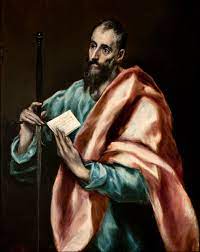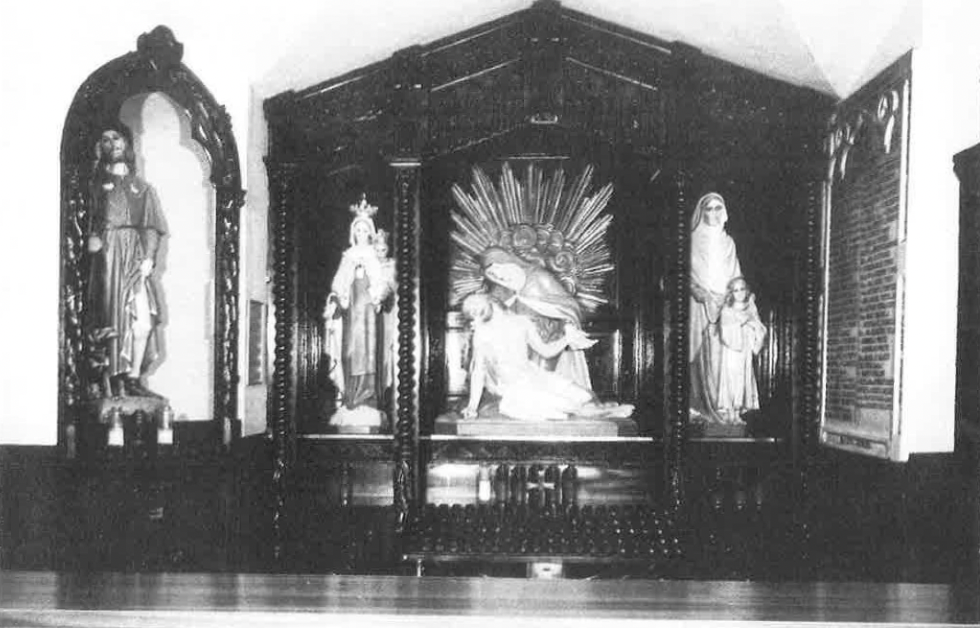
The Five Quarters 1843 – 1969
St. Paul, the patron of this Church, became an Apostle after the Christian religion had been established. The founding of St. Paul’s Church in South Philadelphia occurred one hundred and eleven years after Old St. Joseph’s Church; the first Catholic Church in Philadelphia was built in 1732. Prior to 1801, there were only four Catholic Churches in Philadelphia, Old St. Joseph’s, Willing’s Alley; Old St. Mary’s, Fourth & Marshall; Holy Trinity, Sixth & Spruce; and St. Augustine’s, Fourth and Vine Streets. Then for almost a century, the building of Catholic Churches in Philadelphia was at a standstill. Froni 1831, when St. John the Baptist Church in Manayunk was built, the growth of Catholic Churches mushroomed. The prominent St. John the Evangelist Church, on 13th, South of Market Street, was built in 1832. Subsequently, in rapid order followed the erection of St. Michael’s, St. Patrick’s, St. Francis Xavier, and St. Philip Neri, the latter at Second and Queen Streets, St. Peter’s, then St. Paul’s.
Thus, within the city limits, St. Paul’s Church is the twelfth oldest Church. In 1843, Bishop Kenrick felt the need for a new parish in the much improved and populous district of Moyamensing. This township, when incorporated in 1812, contained not more than 3000 inhabitants and these were scattered over a district that ran from Passyunk A venue on the East to the Schuylkill River on the West. The major part of this district was occupied by farms and truck patches, and the streets were hardly more than roads. Broad and Catherine Streets district was at that time dubbed “Cowtown”, because of the grazing tracts of land.
It was the task of the Reverend Patrick F. Sheridan; in 1843, to organize a new parish within this area and district called Moyamensing, which included everything south of South Street from river to river. Father Sheridan selected the property on which St. Paul’s Church now stands because many of his new parishioners lived nearby. The energy of some of the inhabitants, one of whom was John Maitland of St. Mary’s Parish, foreseeing the possibilities of the territory, transformed the locale into an attractive district. Passyunk A venue, the eastern boundary of the new parish, was the thoroughfare used long before the days of William Penn by the Swedes. It connected two trading posts, one was Point Breeze on the Schuylkill River, and the other at the foot of South Street on the Delaware. The Moyamensing district had a local government consisting of a commission of nine men, who made their headquarters in the various public houses; but then in 1834, they took up their quarters and governed Moyamensing township from the beautiful public building, ornamented with a marble portico, built on the South side of Christian Street between 9th & 10th Streets. This was then labeled the “Commissioners Hall” and was the principal voting place of the district; it was used for public meetings; and here the Court of Justice and the station for the watchmen between the two trading posts were established.
Since this was the most organized and populated area, Father Sheridan chose the property on the north side of Christian Street, between 9th & 10th opposite “Commissioners Hall”, to be the site of St. Paul’s Church. Work was immediately started, and on May 7, 1843, Bishop Kenrick, third bishop of Philadelphia, blessed the corner-stone and placed the parish under the patronage of St. Paul. Although the Church was yet incomplete, the congregation for the first time attended and assisted at the Holy Sacrifice of the Mass offered in St. Paul’s Church by Father Sheridan on Christmas Day, 1843. Due to some anti-religious riots, the completion of St. Paul’s Church was delayed until 1847. The dedication ceremony was conducted by Bishop Kenrick on July 4, 1847.
Soon after the completion and dedication of the Church, the Moyamensing district was divided into four wards (we note that this is irrelevant to St. Paul’s Church, but historically, we include it in the interest of our people). The ·first ward included the territory north of Carpenter Street to South Street, and east of 7th Street. The second, north of Carpenter Street to South Street and between 7th & 11th Streets. The third was west of 11th Street to the Schuylkill between Carpenter and South Streets. The fourth territory still undeveloped was the area south of Carpenter Street. Under the supervision of the nine-man commission, Moyamensing district (South Philadelphia), developed gradually into the ways and manners of city life. It was the fashionable thing to hold picnics and parties, mass meetings, and Fourth of July celebrations in the famous gardens of the district which were also favorite resorts on Sunday for pleasure seekers. Thousands of city sportsmen went to the “Neck” for game at Point Breeze with their horses. One of the most famous resorts was the Lebanon Gardens at 10th & South Streets. Another was the Moyamensing Botanical Gardens on Love Lane (now Washington A venue) between 8th and 11th Streets. This was owned by Alexander Parker and contained a wonderful collection of box trees and rare plants which were carefully cultivated.
Ten years after St. Paul’s founding, the population increased to such proportions in the area, that a new parish was established to provide for the spiritual needs of the growing population. St. Paul’s was the first of the southern parishes to be divided. In 1853 St. Theresa’s Church at Board and Catherine Streets was established. In 1860 another division of St. Paul’s territory formed the boundaries of the Church of the Annunciation at 10th & Dickinson Streets. Thus the present boundaries of St. Paul have been virtually unchanged for over a hundred years.
In 1854 Father Sheridan built a large school on the South side of Christian Street between 8th & 9th, the site of which later developed into the Church of Our Lady of Good Counsel. This school was ready to receive pupils and begin classes in September of 1854. The Sisters of the Holy Cross were first engaged in educating the children of the parish. This community of Sisters remained until 1864, when six Sisters, Servants of the Immaculate Heart of Mary, arrived to take on the new charge. They arrived here from St. Joseph’s Convent, Susquehanna County, and among them were: Mother M. Jerome Ward, Sister M. Loretta Smith, Sister M. Carmella Murphy, Sister M. Thomas Gorman, Sister M. Borgia Matthews, and Sister M. Geneive Morrissey.

The Sisters lived in a few small rooms in the school building until 1869 when a new convent was provided with the purchase of “Commissioners Hall” across the street from the Church. Commissioners Hall was colonial in style, surrounded by spacious lawns extending from Christian Street to Montrose Street. This ground was later used for the two schools of St. Paul’s Parish. During the Civil War, the Hall was used as a hospital for wounded soldiers. Again, during the smallpox epidemic it was used as one ‘of the hospitals to take care of patients with this contageous disease. When the rumor spread that it would permanently be converted into a hospital for communicable diseases, a destructive fire, supposedly the work of an arsonist, broke out. The interior was completely burned out. It was at this time that the parishioners, in 1868, prevailed on the pastor, Father Sheridan, to acquire the property for the use of the Sisters. This property was sold to St. Paul’s Church and the spacious convent was occupied by the Sisters in 1869.
Saint Paul’s Parish was not immune to casualties. Tragedy also stalked St. Paul’s, for in 1861 while Father Sheridan was on a visit to his native Ireland, a fire, attributed to the carelessness of an altar boy, broke out in the Church. Only the walls remained. While the Church was being rebuilt, Mass was celebrated in the school Chapel, located at 8th & Christian Street.
Father Sheridan, too, was not without a cross. In his late years he was afflicted with poor eyesight, and much of his duties were delegated to his assistant. Father Patrick Sheridan died on July 9, 1879 and is buried in a vault on the east side of the Church.

St. Paul’s Parish continued to grow and prosper under the Very Rev. M. A. Walsh, V.G., L.L.D., who was sent here from his pastorate in St. Michael’s to succeed Father Sheridan. Monsignor Walsh was at one time the third Rector of St. Charles’ Seminary. It was while he was pastor of St. Paul’s Church that the rectory at 808 Hutchinson Street, at that time called Lebanon Street, was built. Meanwhile, he took up residence at 718 Christian Street. Father Walsh set about organizing many societies within the Church, thus steady progress was being made spiritually and physically. After the Third Plenary Council of Baltimore, St. Paul’s Church was made, in January 1887, one of the irremovable rectorships of Philadelphia.

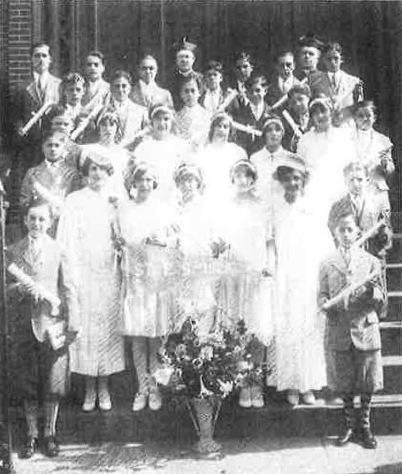
St. Paul’s Church possesses two highly-priced pieces of silverware inscribed with Monsignor Walsh’s name. The serving fork and ladle are about ninety years old. Father Walsh died on November 22, 1888, and was succeeded by Rev. Hugh McGlinn, the pastor of St. Mark’s, Bristol, Pa. His efforts were devoted to renovating and beautifully decorating the Church. While this work was underway, it was discovered that the roof was substantially unsound, and an entire new roof was added to the church. While this work was going on, the statue of St. Paul was placed in the large niche on the outside of the front wall. Along with these improvements, was the remodeling of the sanctuary and installing of a new altar. With this phase of the work being finished, the parish celebrated its golden jubilee on May 17, 1893. On this occassion, a Pontifical Mass was celebrated by Bishop McGovern of Harrisburg. The sermon was delivered by the prominent speaker, Msgr. H. T. Henry.
Father McGlinn died on August 22, 1894, while vacationing in Halifax, Nova Scotia. He was buried at St. Paul’s Church on August 27, 1894. The parish was without a pastor until the Rev. Michael C. Donovan arrived, near the close of November 1894. His previous appointment was the rectorship of St. Leo’s Church in Tacony.
The increase in school enrollment brought about the erection of a new school adjoining the Convent on Christian Street in 1898. The rapidly increasing numbers of Italian immigrants and their urgent need for religious instructions, led to the building of another new school in 1905, to the rear of the “Commissioners Hall” extending to Montrose Street. This building contained a large chapel, gymnasium, shower baths, and home economics room, in addition to twenty-two classrooms which accommodated over 800 children, all of Italian nativity or ancestry.
This new St. Paul’s School, our present school, was blessed by Archbishop Ryan on December 3, 1905. At that time in the two schools, approximately 1500 children attended classes. So from its beginning in 1843, St. Paul’s Parish had, in 1905, achieved the structural form by which we recognize it today. In and around the turn of the century, when the original school at 8th and Christian outgrew its usefulness, the buildings became the foundation of Our Lady of Good Counsel Church in 1898. The church was serviced by the Italian clergy of St. Augustine. In their rapidly growing parish, they saw the need for a school, and so used the original St. Paul’s School at 8th & Christian Streets for classrooms.

The Franciscan Sisters of Peekskill, New York opened Our Lady of Good Counsel Day Nursery and Kindergarten in 1900. Our Lady of Good Counsel School was staffed by more Sisters in 1901. Thus, from the turn of the century, St. Paul’s Church and Our Lady of Good Counsel Church shared many facilities. The Sisters also instituted a private commercial school for girls. They also taught Italian at St. Paul’s School after their regular sessions in Our Lady of Good Counsel. Father Donovan remained as pastor of St. Paul’s until 1913 when the Reverend John C. Fleming succeeded him.
The parish now being a complete entity in its physical properties – the Church, school, convent, and rectory – the maintenance of these buildings became the prime concern of the succeeding pastors. Father John C. Fleming who succeeded Father Donovan as pastor, remained only five years among his congregation when he was appointed to another charge.
The approaching World War I saw Father Francis J. Kane at the helm of St. Paul’s Church. The parish suffered many casualties during the “War that was to end all wars”. Untold sacrifices were made, the parishioners lending a helping hand at home, in hospitals, and in factories. Everywhere was evidence that the “first generation of immigrants” loved their new country. Many died for it. To innumerate or single out any outstanding and valorous deeds would be comparable to counting the drops of water in the ocean. The sea of troubled waters in St. Paul’s Padsh flowed into the vast ocean of the swirling waves of a restless world.
With the cessation of World War I, St. Paul’s once again went through a period of adjustment with the return of men to their homes to worship the God who had blessed them in many respects. Father Kane guided his flock through these critical changes. His devotion and zeal are remembered by some of the surviving members of the parish. In 1924 Father Kane was appointed pastor of Corpus Christi Parish in Philadelphia, and Father Edward J. Lyng, a former Army Chaplain, and director of the Madonna House succeeded him. Like his predecessors, the new pastor strived to improve the spiritual and material welfare of his parishioners. Following his demise on March 10, 1932, the parish was directed by the able administration of Father Joseph McGeever, D.D., now the pastor of St. Edmonds in Philadelphia. It was in 1932 that Our Lady of Good Counsel Church and St. Paul’s Church were consolidated and Father Otto Toffolini was appointed pastor in 1932 by His Eminence Dennis Cardinal Dougherty.
When the two parishes were merged, the Sisters of the Immaculate Heart withdrew in favor of the Sisters of St. Francis; and this transition was smoothly achieved in 1934. In September 1932, the “Front School” on Christian Street was converted into an annex for Roman Catholic Boys High School of the freshman and sophomore classes. The building was completely renovated in adaptation to high school requirements; in September 1933, the increased enrollment caused the opening of an additional annex in the School of St. Mary Magdalen de Pazzi at 8th & Montrose Streets for accommodations of the freshman classes from St. Paul’s annex.
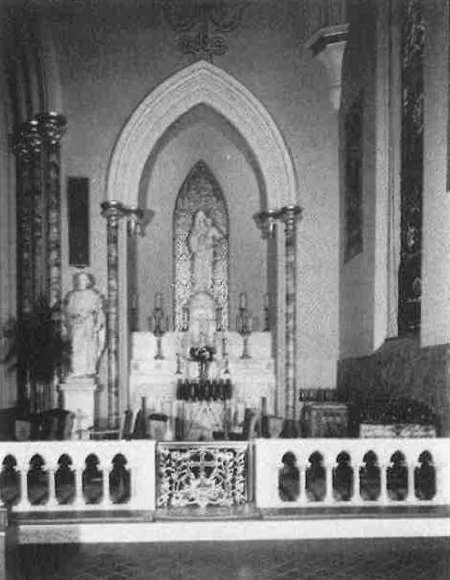
In 1933 by order of His Eminence Dennis Cardinal Dougherty, the neighboring parish of Our Lady of Good Counsel was discontinued. The decision of the Cardinal was that St. Paul’s and St. Mary Magdalen De Pazzi could easily absorb the parishioners of Our Lady of Good Counsel. He felt that the three parishes would not be able to subsist. Although some opposition flared up, the foresight and the wisdom of the distinguished Prince of the Church cannot be questioned today. Thus it was that the two churches which had such mutual boundaries and mingling of personalities merged into the thriving St. Paul’s Parish of today.
Be it in Philadelphia, in St. Paul’s Parish, or in all of America, the source of strength and might of any society is derived from a solution of problems by the united efforts of a willing people. Population transferals create gaps and perplexing situations to be bridged. Integral assimilation of a people into the cultural life of the community is not easily processed. St. Paul’s Parish experienced its first population replacement in the decades pivoted at the turn of the century. Immigrants, especially from Italy, sought a haven in the New World. Too frequently these immigrants, together with all the colors of their own cultures, are shunted off into ghettos, often consigned to live their lives in poor environments. Such situations are doubly fatal because then the people themselves suffer, and the community is deprived of the contributions the new citizens can provide for a richer and fuller society.
The situation in St. Paul’s Parish was similar to other communities. The conversions and blending of ethnic groups and minorities into civic life did not come of itself. Much understanding, a great deal of patience, a warm and generous spirit, and interest in the newcomers was needed, for the transition. These people, arriving from a land that bore the discoverer of the New World, found themselves huddled together in South Philadelphia. They suffered spiritually and materially. There were some 85,000 in number and were served by only two churches and seven priests. The Catholic Church in Philadelphia was aware of this plight and strove to correct it.
In August of 1902, Father Michael Donovan, rector of St. Paul’s Church, confronted with this great need, organized a night school offering courses in manual arts along with religious instructions. He realized that this was merely the beginning and that more extensive measures were needed. But what could one priest do with the tremendous odds against him? Eighty-five thousand non-English speaking people whose twelve thousand children were attending public school or working in the sweatshops of the day were a grave concern.
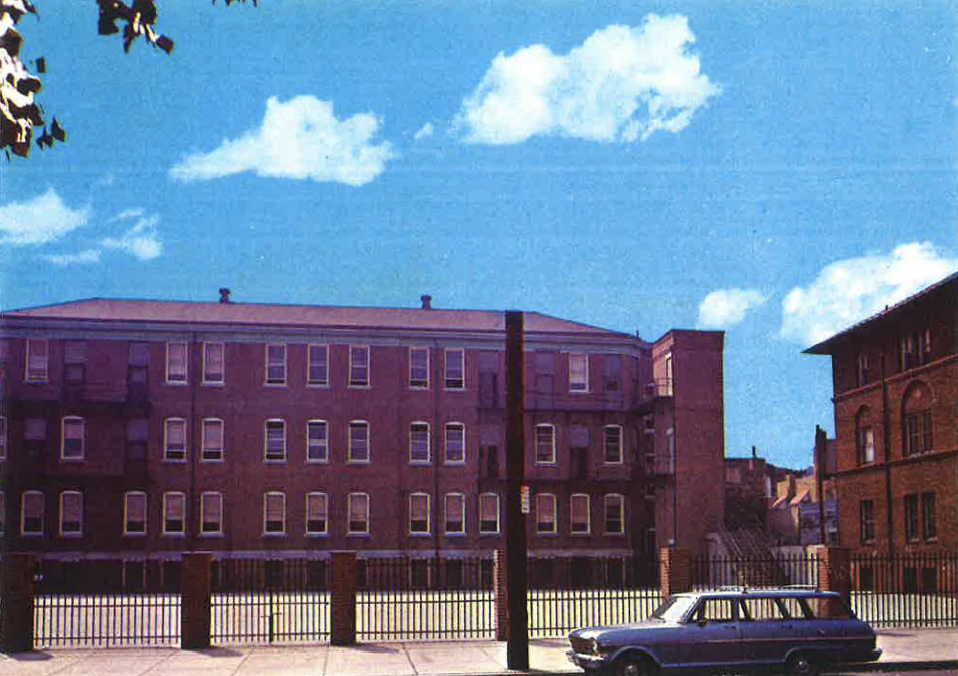
The immigrants, however, had a zealous and apostolic friend. He was Monsignor Henry Drumgoole, a professor at St. Charles Seminary. In 1903 with the approval of His Excellency Archbishop P. J. Ryan, D.D., Archbishop of Philadelphia, Msgr. Drumgoole interested some lay catechists to work for the salvation of souls. From this missionary, instinct was born the historical and famous organization known as the Madonna House. The first location of the Madonna House was a residence at 814 S. 10th Street. On October 8, 1904, with Archbishop Ryan in attendance, a meeting of this missionary society was held in one of the spacious fifteen-room houses. Some prominent laymen, together with Rev. James Turner, the Vicar General, the Rev. Philip R. McDevitt, at that time Superintendent of Schools and later Bishop of Harrisburg, lent their support and encouragement to the Madonna House. With Msgr. Drumgoole in charge, the house, equipped for all immediate needs, soon became a beehive of activity. By the end of 1904, some 600 children were involved in sewing classes, embroidery, dressmaking, manual training, and a sports program.
The influence of the Madonna House began to exert itself, and the need for a new house was apparent. Laymen like Samuel J. Castner, Martin Maloney, Walter George Smith, John J. Sullivan, James M. Wilcox, Ignatius Horstmann, and Emmanuel Nardi, figured largely in the proselytizing work. Their keen interest and untiring zeal contributed much to the success of the Madonna House. To provide more spiritual benefits for the Madonna House children, they obtained the use of the large chapel of St. Paul’s School for Sunday Mass and religious instructions. The work was so extensive and rewarding that Msgr. Drumgoole received an assistant in the appointment of Father Joseph M. Corrigan by Archbishop Ryan. Later Father Corrigan, who became rector of St. Charles Seminary and then Bishop and Rector of Catholic University in Washington, was appointed in 1909 to take complete charge of the Madonna House. Under the paternal care of Archbishop Edmond Prendergrast, the Madonna House spread to other locations in the city. A branch, the Assunta House, was opened at 1208 Reed Street, and another was located in Germantown.
In September 1915, Father Edward J. Lyng was appointed as director of the Madonna House. It was he who obtained the services of the Sisters of the Immaculate Heart of Mary to handle the social and religious activities of the Madonna House. The work continued with mounting success. At a meeting of the board of directors at Cardinal Dougherty’s residence on March 1, 1923, permission was granted to have plans drawn for a new building. This was built at 928 Christian Street, and the cornerstone was blessed by Cardinal Dougherty on April 4, 1924. In recognition of his great work at the Madonna House, Father Lyng was made pastor of St. Paul’s Church in 1924. This was another link toward the eventual merging of Madonna House, Our Lady of Good Counsel Church, and St. Paul’s Church.
The silver anniversary of the Madonna House was celebrated on January 24, 1928, with a banquet in the Bellevue-Stratford Hotel under the patronage of His Eminence Cardinal Dougherty. The main speaker was His Eminence, and others who contributed remarks were Msgr. Drumgoole, Msgr. Corrigan, the Honorable John J. Freschi, Judge Eugene Allessandroni, John J. Silvestro, and the Italian Ambassador.
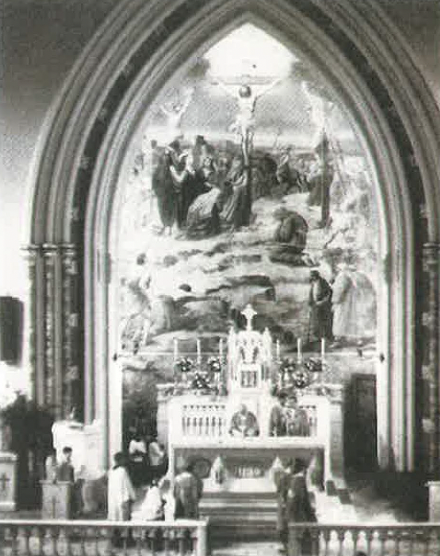
Father Lyng died in March of 1932, and on April 9 of the same year, was succeeded by Father James W. Gibbons, D.D. as director of the Madonna House. With his zeal and industry, the advances accomplished by his predecessors were insured. During Father Gibbons’ tenure, the Missionary Sisters of the Most Blessed Trinity came to take charge of the activities in October 1934. At first, the Sisters commuted to South Philadelphia from the Motherhouse on Solly Avenue in Holmesburg; then, on January 12, 1935, the Don Bosco Missionary Cenacle, 609 S. 10th Street, opened with a Mass celebrated by Father Gibbons. Who but God could tell the enormous good which was accomplished under the wise and kind leadership of the Sisters. In 1952 the Missionary Sisters of the Most Blessed Trinity moved to their present Don Bosco Cenacle at 738 South Tenth Street.
After Father Gibbons left to head the Laymen’s Retreat House in Malvern in 1936, Father Joseph Toye was appointed director. In the footsteps of the pioneers, he moved with the determination of a champion for the salvation of souls. Father Toye labored steadfastly in the work until the Missionary Society was dissolved in the year 1942. When the Catholic Missionary Society was dissolved, the various parishes in South Philadelphia took up the work. St. Paul’s Parish agreed to provide a director for the Madonna House and accept its operation. In 1942 Father Toffolini put the Reverend Edward Flatley in charge of the Madonna House. At this time the Madonna House was moved to 918-20 Carpenter Street. The old Madonna House became the residence of the N orbertine Fathers, who established South East Catholic High School. Father Flatley expended great energy on behalf of the religious, social, and athletic activities of the Madonna House. Father’s kindness and great skill in managing the Madonna House are still remembered by the parishioners of St. Paul’s. In 1949 the Rev. William J. Smith assumed the duties of the Madonna House. His was the last of appointments to the Madonna House.
In 1932, the Reverend Otto Toffolini was made pastor of St. Paul’s Parish and overseer of the Madonna House. He set about healing many broken hearts and soothing the hurt feelings of others. Wrestling with the problems of parishioners, Father Toffolini was stimulated to provide all the spiritual needs of the children and adults of his newly acquired parishioners from Our Lady of Good Counsel. Resentment was counteracted with the establishment of a new Madonna House at 918 Carpenter Street in 1941. The new Madonna House was dedicated by His Excellency, the Most Reverend Hugh L. Lamb, D.D., Auxiliary Bishop of Philadelphia, on Sunday, December 6, 1942, at 4:00 p.m. This also marked the transition of the settlement house of the Archdiocese of Philadelphia to St. Paul’s Parish. The building on Carpenter Street had been renovated at a great expense to make it suitable for instructions and activities among the parishioners.
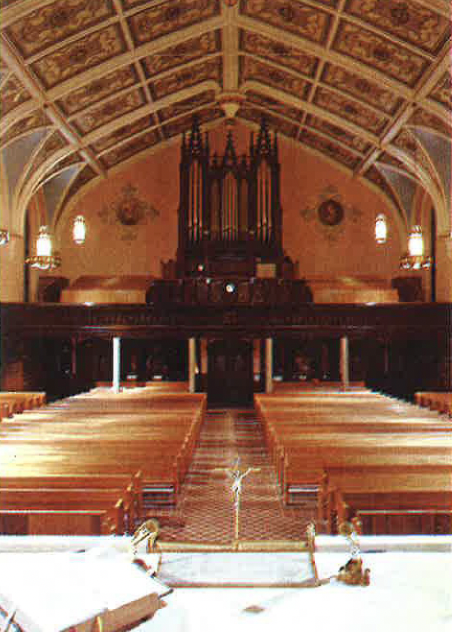
Scanning the parish registry for First Holy Communion records and administration of the Sacrament of Confirmation, one is impressed by the tremendous work accomplished at the Madonna House.
The pages of history would be far too few to recount all the efforts of the twenty-two years Father Toffolini spent as Shepherd of the flock here at St. Paul’s. Difficulties unimaginable confronted him when he assumed charge … difficulties which should be left in the oblivion of time past. Father Toffolini met them with the courage of a true priest and guided his flock well at a time when the sheep were dispersed. The spirit that is St. Paul’s overcame the trials of the time, the depression years; and glows more ardently today because of this great man.
Undaunted by adversity, Father Toffolini made two extensive renovations and repairs to the Church. In 1938 the exquisite hand-carved woodwork was installed. Scenes and symbols from the Old Testament blend into the meaningful teachings and practices of the New Testament. The entire facing of the choir loft, the trimmings of the doors, the framework of the shrines, and the four confessionals, are masterpieces and objects d’art. Love and devotion for his Church and his people are clearly visible in these improvements made by Father Toffolini.
Again in 1946, the church needed repair and remodeling. The pastor again overcame the difficulties, sparing nothing of himself, he adorned, even more, the House of God. The present wrought iron fence surrounding the Church was also the work of Father Toffolini. Failing in health, Father Toffolini took a leave of absence in the year 1954; and the Rev. Michael B. McShane, D.D., assistant Pastor at St. Luke’s in Glenside was appointed administrator of St. Paul’s Parish.
Father Michael B. McShane, D.D., a graduate of St. Joseph’s College, a student at St. Charles Seminary, a graduate of St. John’s Lateran in Rome, a Catholic High School professor, and an Assistant Pastor, applied his abilities to further the cause of St. Paul’s parishioners. Being a man of great learning and wisdom, his first attention was riveted on the school. Shortly after his arrival, a new heating system was installed in the school. The classrooms, one after another were modernized with new lighting fixtures, new desks, new floors, new blackboards, etc. A school library was instituted as early as 1957. Safety precautions were provided by the erection of fire escapes in 1955.
On May 22, 1955, on the east side of_ the Church, the new shrine and statue of Our Lady of Grace was unveiled and dedicated to the· people of St. Paul’s Parish. During the years 1956 and 1957, the sum of $20,000 dollars was raised to furnish the new Church with a new organ. This new instrument replaced the organ that had served the congregation for 80 years.
After sixty years of fine service, “Commissioners Hall”, the old St. Paul’s school, and more recently the Norbertine Faculty House, was demolished in April 1957. While these old landmarks of South Philadelphia had outlived their usefulness, they gave way to the needs of the parish. St. Paul’s School now has a spacious schoolyard. A part of the former Madonna House, now the CYO building remains standing to serve the social life of our adults and youth. The old Madonna House on 918 Carpenter Street was sold in 1959. His Eminence John Cardinal O’Hara, D.D., C.S.C., gave the present CYO building to St. Paul’s Church for the use of its congregation.
Inner city parishes have experienced changes because of industrialization, expressways, and population shifts. St. Paul’s Church has twice been affected by the removal of parishioners to other localities. At the turn of the century, whole streets formerly occupied by Irish American families became populated by Italian-Americans. Another significant trend of removals became in 1952. Some have, however, returned to their familiar surroundings. Despite some loss of the congregation, St. Paul’s Church continued to prosper in the community under the distinguished leadership of Father McShane. Its new Rector set about organizing the Usher Society in 1955. The Mother’s Club, consisting of Mothers of Kindergarten Children, was another of his projects. In 1967, the Home and School Association came into being.
The improvements to the Church were not neglected. The present Public Address System was added to the Church in September 1954. Another cleaning and painting of the Church were undertaken in 1955. The Baptistry was furnished with a new Baptismal Font in 1957. The tower received extensive repairs in 1958. New electronic bells, Schulmeric, were placed into the tower in March of 1964. The Confessionals were modernized and sound-proofed in 1964. The Sanctuary was cleaned, new marble replaced the broken pieces and the old was restored in 1967.
In May of 1968 word was received that His Eminence John Cardinal Krol summoned the Reverend Michael B. McShane to accept the Rectorship of Our Lady of Mount Carmel Church, Doylestown, Pennsylvania. After fourteen years of untiring labor, Father McShane took leave of his beloved parishioners. “There Is No Place Like St. Paul’s” was the popular theme he created. The congregation responded in many ways to his leadership and extended to him best wishes and success in his new pastorate.
In June of 1968 St. Paul’s parishioners welcomed their new Pastor, Rev. Nicholas A. Lazzaro. In a real and true sense, it was welcome, because this was his third coming to St. Paul’s. In December 1941, shortly after his Ordination, he was assigned to St. Paul’s Church as an Assistant. After serving the people of the parish, he was requested to take over the Administrative duties of the Holy Rosary Church in Bethlehem, Pennsylvania, in December of 1947. As the Pastor of that Church returned from his leave of his absence, Father Nicholas A. Lazzaro returned to St. Paul’s Church in December of 1948 to resume his duties as an Assistant. Father Lazzaro again bade farewell to St. Paul’s when he was appointed the Rector of Our Lady of the Angel’s Church, 50th and Master Streets, in July 1950.
Being well acquainted with the people and the community, Father Nicholas A. Lazzaro instantly took up the challenge before him. He refitted the school with new window sashes and frames and recovered the entire roof of the school and the Church. The school children were provided with completely new restrooms and facilities. Contemplating the 125th Anniversary of St. Paul’s Church, Father Nicholas A. Lazzaro made plans to refurbish the Church in 1969. The entire interior of the Church received not only a face uplifting but a renewal. All of the paintings were cleaned, retouched, and some entirely redone. A new Spanish tile floor was set upon the existing deck. New pews were set into place. The Sanctuary was extended, and the altar was remodeled to conform to the decrees of the Vatican Council II. Marble wainscoting replaced the original wooden one. The existing lighting fixtures were adapted to better luminary standards. The Baptistry received a new font, from the donor of the font that had been in use since 1957.
These and many other unwritten events were made possible only through God’s blessing, the intercession of our Patron Saint Paul, and the good will of so many thousands of parishioners of St. Paul. Since 1843, all the deeds, accomplishments and sacrifices are known only to God. The priests who generously served so admirably, and the people who responded to their able leadership, would indeed subscribe to the words of their Patron, Saint Paul: “I have fought the good fight, I have won the race, I have kept the faith. As for the future, a merited crown is reserved for me, anci on that day the Lord, Just Judge that He is, will bestow it on me, and not only on me, but on all who desire His appearance.”(Timothy II, Chapter V7-7)
Feast of St. Joseph the Worker
May 1, 1969
Rev. Joseph F. Sikora
Take a deeper look into the history of St. Paul’s Church through the work of Celeste A. Morello.
